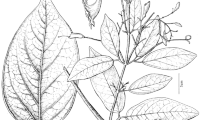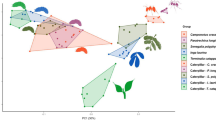Abstract
The attraction of the red turpentine beetle,Dendroctonus valens, to the resin volatiles of its host,Pinus ponderosa, is elicited by three chiral monoterpenes. In field assays response was greatest to (S)-(−)-β-pinene; 92% (S)-(−)-α-pinene found inP ponderosa resin was not attractive. However, 75% (R)-(+)-α-pinene, which occurs inPinus lambertiana, a sympatric host ofD. valens, was attractive. (S)-(−)-α-Pinene interrupted response to (R)-(+)-α-pinene. (S)-(+)-3-Carene from both hosts was attractive at the (R)-(+)-α-pinene level. Three sympatric coniferous nonhosts each have the same attractive monoterpenes but produce less resin. These studies demonstrate the importance of chirality of host compounds in the host finding behavior of this bark beetle.
Similar content being viewed by others
References
Birch, M.C., Light, D.M., Wood, D.L., Browne, L.E., Silverstein, R.M., Bergot, B.J., Ohloff, G., West, J.R., andYoung, J.C. 1980. Pheromonal attraction and allomonal interruption ofIps pini in California by the two enantiomers of ipsdienol.J. Chem. Ecol. 6:703–717.
Borden, J.H. 1985. Aggregation pheromones, L.I. Gilbert, (ed.).in Comprehensive Insect Physiology Biochemistry and Pharmacology, pp. 257–285, Pergamon Press, Oxford.
Chénier, J.V.R., andPhilogéne, B.J.R. 1989. Field responses of certain forest Coleoptera to conifer monoterpenes and ethanol.J. Chem. Ecol. 15:1729–1745.
Dethier, V.G. 1954. Evolution of feeding preferences in phytophagous insects.Evolution 8:33–54.
Elkinton, J.S., andWood, D.L. 1980. Feeding and boring behavior of the bark beetleIps paraconfusus (Coleoptera: Scolytidae) on the bark of a host and non-host tree species.Can. Entomol. 112:797–809.
Fatzinger, C.W. 1985. Attraction of the black turpentine beetle (Coleoptera: Scolytidae) and other forest Coleoptera to turpentine-baited traps.Environ. Entomol. 14:768–775.
Goheen, D.J., Cobb, F.W., Wood, D.L., andRowney, D. 1985. Visitation frequencies of some insect species onCeratocystis wageneri infected and apparently healthy ponderosa pines.Can. Entomol. 117:1535–1543.
Lewis, T. (ed.). 1984. Insect Communication. Academic Press, London, 414 pp.
Lindgren, B.S. 1983. A multiple funnel trap for scolytid beetles (Coleoptera).Can. Entomol. 115:299–302.
Moeck, H.A., Wood, D.L., andLindahl, K.Q. 1981. Host selection behavior of bark beetles (Coleoptera: Scolytidae) attackingPinus ponderosa with special emphasis on the western pine beetle,Dendroctonus brevicomis. J. Chem. Ecol. 7:49–83.
Owen, D.R. 1985. The role ofDendroctonus valens and its vectored fungi in the mortality of ponderosa pine. PhD dissertation. University of California, Berkeley, 64 pp.
Payne, T.L., Billings, R.F., Delorme, J.D., Andryszak, N.A., Bartels, J., Francke, W., andVité, J.P. 1987. Kairomonal-pheromonal system in the black turpentine beetle,Dendroctonus terebrans (OI).J. Appl. Entomol. 103:15–22.
Phillips, T.W., Nation, J.L., Wilkinson, R.C., Foltz, J.L., Pierce, H.D., Jr., andOehlschlager, A.C. 1990. Response specificity ofDendroctonus terebrans (Coleoptera: Scolytidae) to enantiomers of its sex pheromones.Ann. Entomol. Soc. Am. 83:251–257.
Phillips, T.W., Wilkening, A.J., Atkinson, T.H., Nation, J.L., Wilkinson, R.C., andFoltz, J.L. 1988. Synergism of turpentine and ethanol as attractants for certain pine-infesting beetles (Coleoptera).Environ. Entomol. 17:456–462.
Renwick, J.A.A., Hughes, P.R., andKrull, I.S. 1976. Selective production ofcis- andtrans- verbenol from (+)-α-pinene by a bark beetle.Science 191:199–201.
Renwick, J.A.A., andRadke, C.D. 1983. Chemical recognition of host plants for oviposition by the cabbage butterfly,Pieris rapae (Lepidoptera: Pieridae)Environ. Entomol. 12:446–450.
Schneider, D. 1957. Elektrophysiologische Untersuchungen von Chemo-und Mechanorezeptoren der Antennae des Seidenspinners.Bombyx moriL.Z. Vergl. Physiol. 40:8–41.
Smith, R.H. 1971. Red turpentine beetle. USDA Forest Service. Forest Pest Leaflet 55, 8 pp.
Thorsteinson, A.J. 1960. Host selection in phytophagous insects.Annu. Rev. Entomol. 5:193–218.
Visser, J.H. 1986. Host odor perception in phytophagous insects.Annu. Rev. Entomol. 31:121–144.
Vité, J.P., andGara, R.I. 1962. Volatile attractants from ponderosa pine attacked by bark beetles (Coleoptera: Scolytidae).Contrib. Boyce Thompson Inst. 21:251–274.
White, P.R., andBirch, M.C. 1987. Female sex pheromone of the common furniture beetleAnobium punctatum (Coleoptera: Anobiidae): Extraction, identification, and bioassays.J. Chem. Ecol. 13:1695–1706.
Wood, D.L. 1982. The role of pheromones, kairomones, and allomones in the host selection and colonization behavior of bark beetles.Annu. Rev. Entomol. 27:411–446.
Wood, S.L. 1982. The bark and ambrosia beetles of North and Central America (Coleoptera, Scolytidae): A Taxonomic monograph. Great Basin Naturalist Memoirs No. 6.
Author information
Authors and Affiliations
Rights and permissions
About this article
Cite this article
Hobson, K.R., Wood, D.L., Cool, L.G. et al. Chiral specificity in responses by the bark beetleDendroctonus valens to host kairomones. J Chem Ecol 19, 1837–1846 (1993). https://doi.org/10.1007/BF00983790
Received:
Accepted:
Issue Date:
DOI: https://doi.org/10.1007/BF00983790




